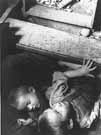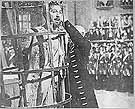
|
|
|

|

|

|

|
|
Click on an image to see a larger, more detailed picture.
|
|
|
|
|
| 1940: Machinery of Hatred |

|
pg. 202 |

|
|
|
|
| |
 This wedding photograph of Hala Buchwajc and Motek Lichtensztajin, taken in the Bedzin Ghetto, belies the harsh reality of life for Polish Jews. Married in 1940, the newlyweds were separated when they arrived at Auschwitz. After they were transferred to different camps, the young couple lost track of each other and feared the worst. Miraculously, however, Hala and Motek were reunited in 1946 when the two met by chance on the streets of London.
This wedding photograph of Hala Buchwajc and Motek Lichtensztajin, taken in the Bedzin Ghetto, belies the harsh reality of life for Polish Jews. Married in 1940, the newlyweds were separated when they arrived at Auschwitz. After they were transferred to different camps, the young couple lost track of each other and feared the worst. Miraculously, however, Hala and Motek were reunited in 1946 when the two met by chance on the streets of London.
Photo: Joan Liwer Wren / United States Holocaust Memorial Museum Photo Archive
|
 Two young children of the Bedzin (Poland) Ghetto peacefully bide their time. Occupied by the Germans on September 4, 1939, Bedzin had 27,000 Jewish inhabitants, approximately 45 percent of the town's entire population. Confiscation of Jewish property, forced labor, deprivation, and, ultimately, deportation to Auschwitz were slated for the Jews of Bedzin. After the first wave of deportations to Auschwitz, a Resistance movement attempted to make contact with the Polish underground. The ghetto was liquidated by the Nazis in August 1943.
Two young children of the Bedzin (Poland) Ghetto peacefully bide their time. Occupied by the Germans on September 4, 1939, Bedzin had 27,000 Jewish inhabitants, approximately 45 percent of the town's entire population. Confiscation of Jewish property, forced labor, deprivation, and, ultimately, deportation to Auschwitz were slated for the Jews of Bedzin. After the first wave of deportations to Auschwitz, a Resistance movement attempted to make contact with the Polish underground. The ghetto was liquidated by the Nazis in August 1943.
Photo: Arnold Shay / United States Holocaust Memorial Museum Photo Archive
|
 The execution of Jud Süss (actor Ferdinand Marian) provides the climax of the antisemitic feature film Jud Süss. Directed by Veit Harlan and released in September 1940, the film was deemed by the Nazis as especially "worthwhile" for young people. Aggressively promoted by Propaganda Minister Joseph Goebbels and backed by a budget of two million Reichsmarks, the film portrayed the scandalous financial tricks of Joseph Süss Oppenheimer, the advisor to Duke Karl Alexander of Württemberg, Germany, in the early 1700s. The film's explicit antisemitic message, coupled with powerful performances, had an inflammatory impact on audiences. Attacks against Jews were common after showings of the film.
The execution of Jud Süss (actor Ferdinand Marian) provides the climax of the antisemitic feature film Jud Süss. Directed by Veit Harlan and released in September 1940, the film was deemed by the Nazis as especially "worthwhile" for young people. Aggressively promoted by Propaganda Minister Joseph Goebbels and backed by a budget of two million Reichsmarks, the film portrayed the scandalous financial tricks of Joseph Süss Oppenheimer, the advisor to Duke Karl Alexander of Württemberg, Germany, in the early 1700s. The film's explicit antisemitic message, coupled with powerful performances, had an inflammatory impact on audiences. Attacks against Jews were common after showings of the film.
Photo: United States Holocaust Memorial Museum Photo Archive
|
|

|

|

|

|
 September 5, 1940: German occupation authorities in Luxembourg introduce Nuremberg Laws. All Jewish businesses are seized and handed to "Aryans."
September 5, 1940: German occupation authorities in Luxembourg introduce Nuremberg Laws. All Jewish businesses are seized and handed to "Aryans."
|
 September 5, 1940: Bishop Theophil Wurm, head of the provincial Lutheran Church at Württemberg, Germany, sends a second letter to German Interior Minister Wilhelm Frick expressing his objections to "euthanasia" killings.
September 5, 1940: Bishop Theophil Wurm, head of the provincial Lutheran Church at Württemberg, Germany, sends a second letter to German Interior Minister Wilhelm Frick expressing his objections to "euthanasia" killings.
|
 September 7, 1940: The Germans' "blitz" bombing of Great Britain begins.
September 7, 1940: The Germans' "blitz" bombing of Great Britain begins.
|
 September 11, 1940: The Jewish refugee ship Quanza stops to refuel at Norfolk, Virginia, after having been denied entry to the United States at New York and to Mexico at Vera Cruz. One passenger, a German Jew, is returned to the ship by U.S. Army guards after leaping overboard near the shore of Hampton Roads, Virginia.
September 11, 1940: The Jewish refugee ship Quanza stops to refuel at Norfolk, Virginia, after having been denied entry to the United States at New York and to Mexico at Vera Cruz. One passenger, a German Jew, is returned to the ship by U.S. Army guards after leaping overboard near the shore of Hampton Roads, Virginia.
|
|
|
|
|
| 1940: Machinery of Hatred |

|
pg. 202 |

|
|
The Holocaust Chronicle
© 2009 Publications International, Ltd.
|
|
